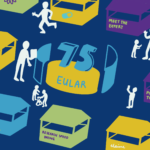Australia is well represented at EULAR 2022, which started yesterday in Copenhagen and online.
Australia is well represented at EULAR 2022, which started yesterday (Wednesday) in Copenhagen and online.
With plenty more still to come, here are some sessions and posters to watch out for.
Oral presentations
Some of the key sessions to watch out for are as follows – all times are Central European Summer Time (CEST).
In the session on Remission, flares and predictive factors in SLE, Sjogren and anti-phospholipid syndrome (2 June, 10:30-12:00), Professor Eric Morand is presenting the results of an Asia Pacific Lupus Collaboration study looking at damage accrual and flares associated with low disease activity state in patients with recent onset SLE. This cohort of patients was compared to patients with established disease, where the associations are better known.
- OP0142 – Comparison of attainment and protective effects of the lupus low disease activity state in patients with newly diagnosed vs established SLE – a multi-centre prospective study (2 June, 10:35-10:45)
Professor Morand is also presenting a late-breaking oral abstract on 4 June (12:00-13:15) on the efficacy and safety of TYK2 inhibitor deucravacitnib. The results of the 48-week phase 2, randomised, double-blind, placebo-controlled study were promising, and the authors recommend further investigation in the phase 3 trials.
- LB0004 – Efficacy and safety of deucravacitnib, an oral, selective, allosteric TYK2 inhibitor, in patients with active systemic lupus erythematosus (4 June, 12:00-12:10)
There are two Australian presentations in the session New developments in osteoarthritis, on Friday 3 June (10:30-12:00), quantifying the effects of body weight on knee osteoarthritis and its consequences:
Dr Sultana Hussain of Monash University is presenting the results of prospective cohort study linking different BMI trajectories over participants’ adult life and the incidence of total knee arthroplasty, demonstrating the importance of preventing weight gain from young adulthood to midlife.
- OP0226 – Trajectories of body mass index from early adulthood to late midlife and incidence of total knee arthroplasty for osteoarthritis (3 June, 11:05-11:15).
This is followed by Zubeyir Salis of the University of NSW, presenting the results of a prospective multi-cohort study which found each unit of change in BMI was linked with a 5-8% change in odds of incidence and progression of the structural defects of knee osteoarthritis.
- OP0227 – Weight loss is associated with reduced incidence and progression of structural defects in knee osteoarthritis as assessed by radiography over 4 to 5 years (3 June, 11:15-11:25)
Also on 3 June is the session Rheumatoid arthritis: Clinical aspects and comorbidities – II (10:30-12:00), with Professor Hans Nossent of the University of Western Australia presenting comparative data on the incidence rates for hospitalisation with opportunistic infections, including tuberculosis and herpes zoster, among patients with inflammatory joint diseases before and after the introduction of biologics. The rate was twice as high for RA patients compared to AS and PsA patients, though admission rates for most opportunistic infections have decreased in RA patients over time.
- OP0274 – Hospitalisation for tuberculosis and other opportunistic infections in patients with inflammatory joint diseases before and after the introduction of biological therapy (3 June, 11:05-11:15).
In the Health Professionals in Rheumatology (HPR) interventions in the spotlight (3 June, 10:30-12:00), Dr Antoni Fellas is presenting the findings of a multicentre randomised clinical trial that investigated the effect of customised prefabricated foot orthoses in reducing pain in children and adolescents with JIA. Compared with a sham intervention (a flat leather board with no corrective modifications) the orthoses resulted in a clinically and statistically significant reduction in pain within the first 3 months.
- OP0207 – Effect of foot orthoses in reducing pain in children with juvenile idiopathic arthritis (3 June, 11:45-11:55)
Posters
With over 60 posters involving Australian research or researchers, there’s plenty to look at. Here are some of the main ones:
Poster tours
POS0057 Inducible regulatory synovial macrophages: a proof-of-concept study for a cell-based targeted therapy for rheumatoid arthritis (A Small, K Lowe, A Ferrante et al)
POS0121 Association of lupus low disease activity state attainment with reduced organ damage and flare in SLE patients with high disease activity (R Kandane-Rathnayake, V Golder, W Louthrenoo et al, presented by EF Morand)
POS0178 Association between knee MR imaging markers and knee symptoms over 7 years in young adults (B Antony, A Venn, L Blizzard et al)
Posters only
POS0691 Emulating a target trial of adalimumab versus tofacitinib in patients with rheumatoid arthritis: a comparative effectiveness analysis using the OPAL real-world dataset (C Deakin, B De Stavola, G Littlejohn et al)
POS0751 Temporal trend in hospitalisation for opportunistic infections in patients with connective tissue diseases (J Nossent, H Keen, D Preen, C Inderjeeth)
POS0769 Cancer development in patients hospitalised with systemic lupus erythematosus: a longitudinal, population-level data linkage study (W Raymond, D Preen, H Keen et al)
POS0770 Increased risk of fracture, recurrent fracture and post-fracture mortality in patients with systemic lupus erythematosus: a population-level linked data study (W Raymond, C Inderjeeth, D Preen et al)
POS0774 Anti-SM autoantibodies identify a phenotype of severe SLE with an associated serum biomarker profile (A Hoi, S Toor, J Monk et al)
POS0856 Defining the clinical utility of PET or PET/CT in idiopathic inflammatory myopathies: a systematic literature review (G Bentick, J Fairley, I Wicks et al)
POS1019 Real-world evaluation of treatment patterns and persistence of tofacitinib in treatment of psoriatic arthritis in Australia: an analysis of the OPAL dataset (G Littlejohn, J Leadbetter, B Butcher et al)
POS1034 Evolving mechanism of action preference for the treatment of psoriatic arthritis in Australia: an analysis of the OPAL dataset (P Youssef, S Ciciriello, GS Ngian et al)
POS1105 Efficacy and safety of colchicine for the treatment of osteoarthritis: a systematic review and meta-analysis of intervention trials (A Singh, P Molina-Garcia, S Hussein et al)
POS1116 Dietary inflammatory index and knee structures on MRI and pain: a prospective cohort study (F Pan, J Tian, M Cervo et al)
POS1118 Metformin as a potential disease-modifying drug in osteoarthritis: A systemic review of pre-clinical and human studies (Y Lim, Y Wang, M Estee et al)
POS1119 Efficacy of corticosteroids for hand osteoarthritis: a systemic review and meta-analysis of randomised controlled trials (M Estee, F Cicuttini, M Page et al)
POS 1125 Efficacy of tumor necrosis factor inhibitors in hand osteoarthritis: a systemic review and meta-analysis of randomised controlled trials (M Estee, F Cicuttini, M Page et al)
POS1425 The burden of osteoarthritis across the states of India, 1990-2019: findings from the global burden of disease study 2019 (A Singh, SK Das, A Chopra)
POS1442 The prevalence of rheumatoid arthritis in Western Australia extrapolated from hospitalisation and biological therapy usage data (K Almutairi, C Inderjeeth, D Preen et al)
On-demand viewing of sessions is available from 5 June to 31 July 2022.




